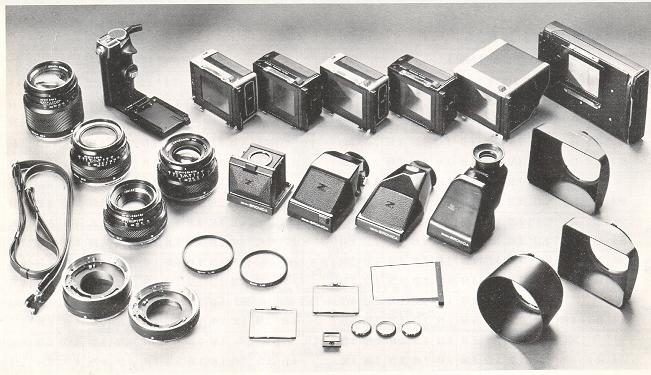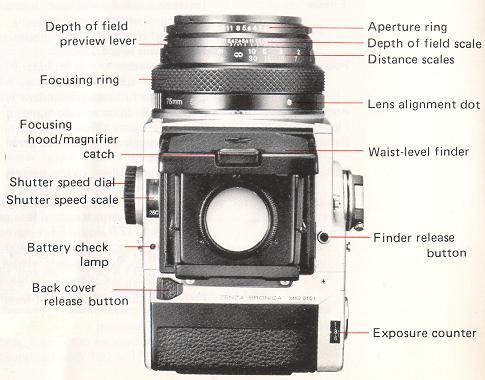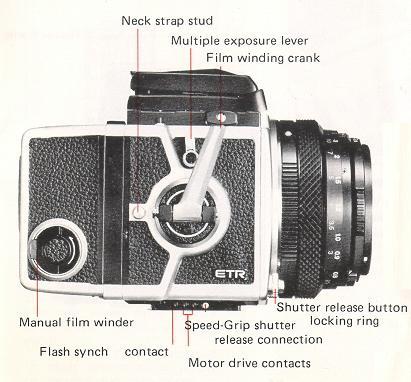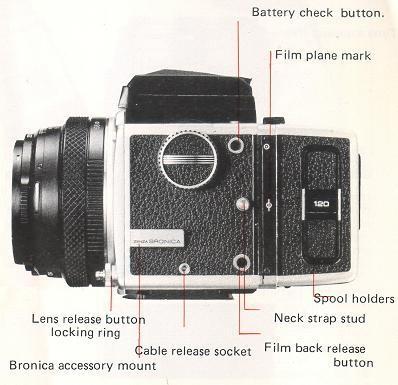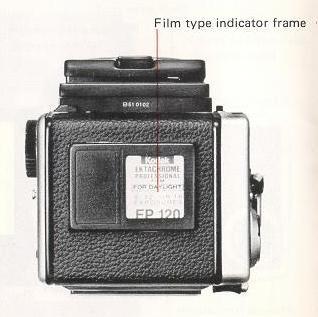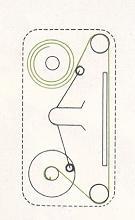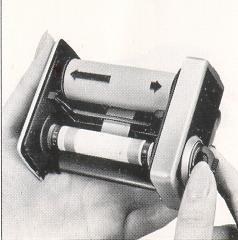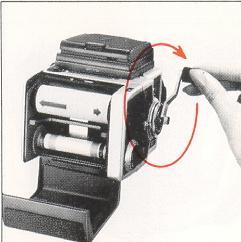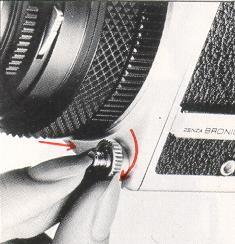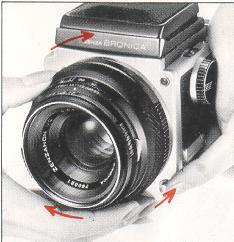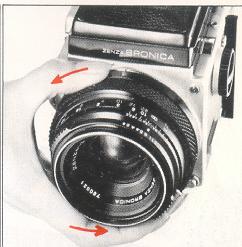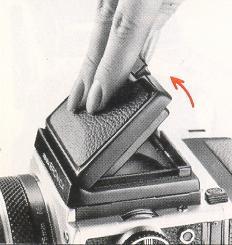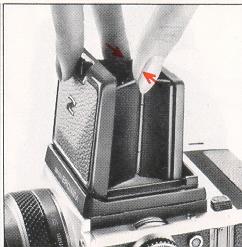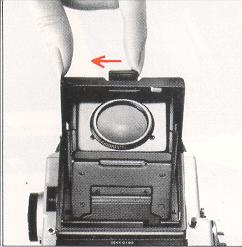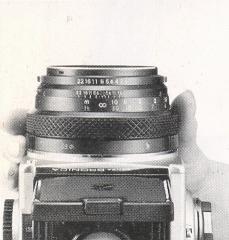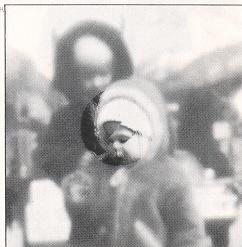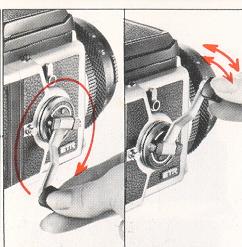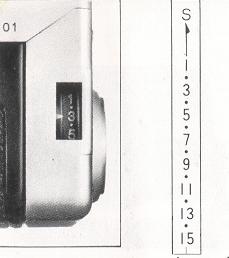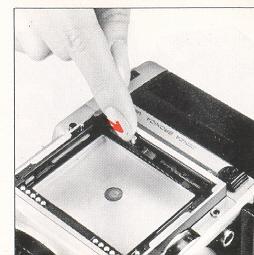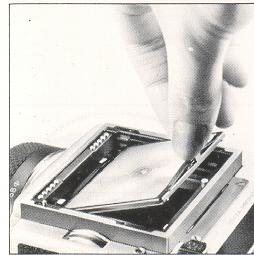Bronica ETR
Posted 12-30-'02
This camera manual library is for reference
and historical purposes, all rights
reserved.
This page is copyright© by

,
M. Butkus, NJ.
This page may not be sold or distributed without the
expressed
permission of the producer.
I have no connection with any camera company.
On-line camera manual library
If you find this manual useful,
how about a donation of $3 to:
M.
Butkus, 29 Lake Ave.,
High Bridge, NJ 08829-1701
and send your e-mail address
so I can thank you.
Most other places would charge
you $7.50 for a electronic copy
or $18.00 for a hard to read Xerox copy.
This
will help me to continue to host this site,
buy new manuals, and pay their shipping costs.
It'll make you feel better,
won't it ?
If you use Pay Pal, use the link below.
Use the above address for a check, M.O. or cash.
Venmo @mike-butkus-camera Ph 2083
Back to main camera manual page
<<< IF YOU WOULD LIKE THIS OR ANY PDF FILE
PRINTED, BOUND AND MAILED TO YOU,
SEE THIS OUTSIDE COMPANY'S OFFER >>>
Problems
opening PDF files or printing problems
- click here
Click here to
Bronica ETR PDF
version
of this manual - better printing

Congratulations on your choice of the Zenza Bronica ETR single lens reflex camera which will offer you high quality performance, handling
convenience and versatility required for professional photography. The Zenza Bronica ETR has been developed as a complete modular
"system" camera, with a very high degree of interchangeability in lenses, finders, focusing screens, film backs, etc. At the same time, it has
a full range of other valuable accessories which will permit its use in many other day-to-day assignments, requiring a fast-handling camera
with complete exposure automation.
To get best results from your camera, may we suggest that you read this instruction manual carefully, before you even touch the camera.
Thoroughly familiarize yourself with its working parts, before loading your first roll of film, and your pleasure in using the Zenza Bronica
ETR will be even greater.
CONTENTS
|
Specifications of the ZENZA BRONICA ETR 2
Parts of the ZENZA BRONICA ETR 4
1. Loading the Battery . . . . 7
2. Checking the Battery . . . . . 8
3. Film Loading . . . . . . . 8
4. Film Unloading . . . . . . . 12
5. Setting the Shutter Speed Dial . . . . . . 13
6. Time (T) Exposures . . . . . . . 14
7. Exchanging Lenses . . . . . . . . 15
8. Waist-Level Finder . . . . . . . 16
9. Setting the Aperture . . . . . . . 17
10. Focusing Adjustments . . . . . . 18
11. Film Advance and Shutter Winding . . . . . . 19
12. Exposure Counter . . . . . . . . . . . . . 19
13. Shutter Release Button . . . . . . . 19
14. Distance Scale and Depth of Field Scale. .21
15. Infrared Photography . . . . . . . . 22 |
16. Flash Photography . . . . . . . 22
17. Multiple Exposures . . . . . . . . 23
18. Attachment and Removal of Film Backs . . . . . . . . 24
19. Interchanging Finders and Magnifiers . . . . . . . . 25
20. Interchanging Focusing Screens . . . . . . . . . 26
21. Film Type Indicator Frame . . . . . . . . . . 27
22. Attaching and Removing the Neck Strap . . . . . . . . . 28
23. Facts about the Battery . . . . . . . . . 29
24. Pointers on Shooting with the Zenza Bronica ETR . . . . . . . .
. 30
25. Care of the Zenza Bronica ETR . . . . . . . . . . 31
26. Accessories for Increasing the Versatility of the ETR . . . . . . 32
27. Zenzanon Interchangeable Lenses . . . . . . 33
Depth of Field Table . . . . . . . 35
Accessories for the Zenza Bronica ETR . . . . . . . 36 |
Type 4.5cm x 6cm format lens shutter single lens reflex camera, with interchangeable lens, film back, finder and focusing screen systems.
Frame size 42.5mm x 55.1mm (side/length ratio of 1:1.29 closely matches standard paper and reproduction sizes)
Film 120 roll film (15 exposures)
Standard lens Zenzanon E 75mm F2.8 lens; interchangeable type; 5 elements in 4 groups; multi-layer anti-reflection coated;
50° angle of view, F22 minimum aperture, helical focusing from inf. to 60cm.(2 ft.)
Filter size 58mm diameter thread mount on 75mm lens; 62mm diameter thread mount on lenses from 40mm to 250mm focal lengths.
Lens mount Exclusive four claw Bronica bayonet mount.
Lens diaphragm Fully automatic instant reopening lens diaphragm action; equal-distant aperture scale graduations; depth of field previewing.
Shutter Electronic control SEIKO #O between-lens leaf shutter; shutter speeds 8 sec. to 1/500 sec. plus T (time exposures); mechanical control setting 1/500 sec.
Multiple exposure Multiple exposures possible with lever on body.
Film back Daylight loading interchangeable type, exclusive backs for 120 (15 exposures) and 220 (30 exposures} roll fims,70mm (90 exposures) film and Polaroid film pack.
(Supplied with 120 roll film back.)
Finder Interchangeable waist-level focusing hood; single-action opening/closing; flip-up interchangeable type magnifier (standard magnifier --1.5 diopter); finder magnification with 75mm lens 1.25x.
Focusing screen Interchangeable type; standard type has split-image rangefinder spot surrounded by microprism ring; matte center with full-area fresnel lens type also available.
Accessory mount Exclusive Bronica accessory mount on left side of body.
Flash synchronization X-setting (up to 1/500 sec.)
Battery checking Battery check button plus green-colored LED light on top of body.
Battery Single-6-volt silver oxide battery (Eveready No. 544, UCAR No. 544 or Mallory No. PX-28).
Dimensions 110mm (4-1/2") wide x 106mm (4-1/4") high x 157mm (6-1/4") long (with standard lens and waist-level finder).
Weight 1,346 grams (2.9 lbs.):
ETR camera with waist level finder and 75mm F2.8 lens
493 grams (1 lb.): ETR body only (with battery)
326 grams (11.4 oz.): 120 roll film back only
417grams (14.60z.): 75mm F2.8 lens only
110 grams (3.8 oz.): Waist level finder only
PARTS OF THE ZENZA BRONICA ETR
1. LOADING THE BATTERY
 |
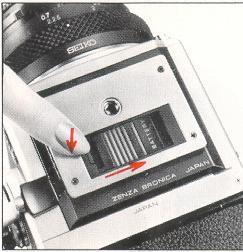 |
A. The electronically-controlled shutter will not work without loading the battery.
The shutter will be mechanically controlled, without a battery, and will be released at 1/500 sec., regardless of the setting on the shutter speed dial.
Use one silver oxide battery (EVEREADY No.544 or equivalent).
* The battery can be purchased in most photographic supply or electrical appliance stores.
|
 |
B. Depress the battery chamber button with your finger while, at the same time, moving the battery chamber cover in the arrow-indicated direction and the cover will come off.
C. Coincide the polarity marks (+) ( -) on the battery with similar polarity indications in the battery chamber. Then, push in the negative end of the battery first and follow with the
positive end.
Insert the battery chamber cover into place, by first inserting the end marked BATTERY. Then move the cover opposite to the arrow-indicated direction until it locks.
* Should the battery be reversed, the shutter will only work mechanically at 1/500 sec. |
2. BATTERY CHECKING
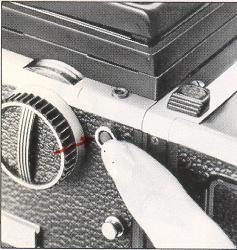 |
If the green-colored battery check lamp lights up when the battery check button is depressed, the battery is loaded properly and there is sufficient power for electronically-con
trolled operations.
* If the lamp does not light up ( 1 ) the battery is not loaded properly or (2) the battery is completely drained and should be exchanged.
|
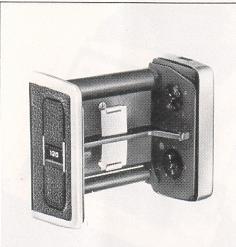 |
A. The film back consists of a film holder and a film back frame, with exclusive film holders supplied for 120 and 220 roll films.
The film holder has an insert or frame for loading film, as well as a built-in film winding mechanism.
|
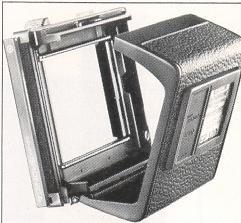 |
B. The film back frame, on the other hand, consists of a base with a dark slide slit and a back cover with a film type indicator frame. The film back frame completely encloses
the film holder and shields it from outside light (see page 24), as well as connecting it to the camera body. |
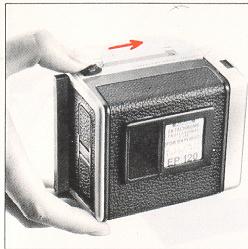 |
C. Pushing the back cover opening button inwards (in the
arrow indicated direction ) opens the back cover and permits the film holder to be detached.
|
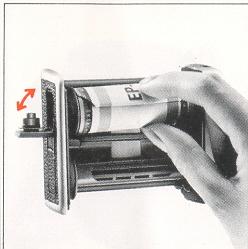 |
D. There are two spool holders on the film holder. The top one is for the fresh film spool while the bottom one is for the empty take-up spool. The left-side shafts of both spool
holders can be opened outwards, as illustrated. Therefore, insert the right end of the spool on to the right-side shaft, which is fixed, and then close the
left side holder (shaft)
which will engage the spool.
* The spool holders on the left side will be locked securely, when the back cover is closed.
|
E. When the fresh film spool is properly loaded in the top spool holder, draw out the leading end of the film and turn it across the film pressure plate (on the front side of the
insert). After running it down to the lower end, turn it over to the empty take-up spool. Insert the leading end of the film into the slit of the take-up spool and wind slightly so that it
is securely engaged.
* The inside of the leader paper must be facing out, when it is running across the film pressure
F. Unfold the manual film winder on the right side of the film holder and rotate in the arrow-indicated direction, while checking the advancing film. When the starting point, or
arrow mark, is aligned with the triangular  start-mark on the top left side of the film holder, stop rotation.
start-mark on the top left side of the film holder, stop rotation.
G. The film can be loaded in the film holder, without detachment from the camera body, and should be loaded in the same manner as explained for the detached film holder.
However, the starting point, or arrow mark, should be aligned to the start-mark by advancing the film with the film winding crank on the camera body.
* If the film is not advanced when the film winding crank is rotated, the film holder is not inserted properly and/or the camera body may be set for multiple exposures. In the latter
case, return the multiple exposure lever to an upright or vertical position.
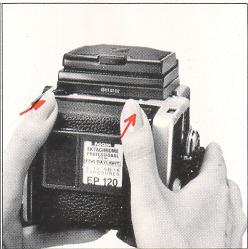 |
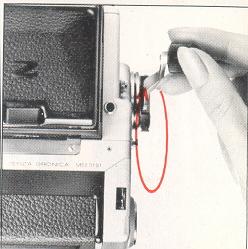 |
H. Close the back cover, by pressing it strongly against the base of the film back, as illustrated. The back cover will automatically lock and close.
The same operation will close the back cover when the film back is detached from the body.
I. Upon loading the film, rotate the film winding crank until it stops to place the first frame into place for taking the picture. The exposure counter will also change from "S" to "1",
while the shutter will also be wound.
The manual film winder on the film back should be used to advance the film to its first frame, when the film back is detached from the body. However, the manual film winder will
not stop rotating.
4. FILM UNLOADING
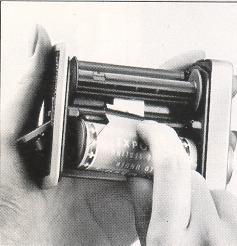 |
A. After the 15th exposure of the 120 roll film (30th exposure of the 220 roll film), the film winding crank will turn freely with further rotations. Therefore, continue rotating the film
winding crank until the remaining film and all the leader paper is wound up on the take-up spool.
Open the back cover when winding action becomes very light.
B. Remove the film holder and, while preventing the loose film from unwinding, take out the take-up spool. Seal the exposed film and return it to its original box until
development.
* Load and unload film away from direct sunlight and/or strong illumination. |
5. SETTING THE SHUTTER SPEED DIAL
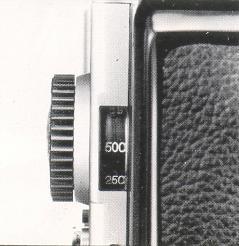 |
A. The numerals on the shutter speed scale are the shutter speed settings, which are placed in the window on the top left-side of the body with the shutter speed dial.
The numbers 1 to 8S are full numbers while numbers 2 to 500 are fractions of a second. For example, "8S" is 8 seconds, "2S" is 2 seconds and "500" is 1/500 sec.
* When the battery is not loaded or is drained, the shutter is released at 1/500 sec., regardless of the setting.
B. The numbers on the shutter speed scale are color-coded in red and white colors. The
red colored numbers are full number settings of 1 second and longer while the white-colored numbers are settings from 1/2 to 1/500 second.
See the following page for T (time exposures).
There is no B (bulb) setting on the shutter speed dial.
The shutter speed dial can be freely rotated in either direction. |
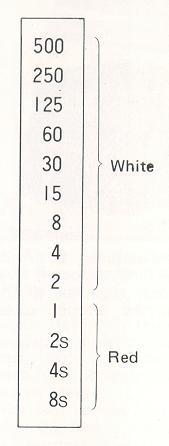 |
6. TIME (T) EXPOSURES
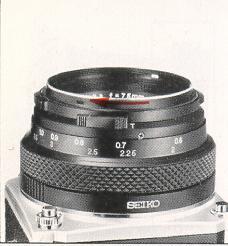 |
A. Time exposures are made with the time exposure lever on the lens, regardless of the setting on the shutter speed scale. |
|
B. First, wind the shutter with the film winding crank and then shift the time exposure lever to the left (looking from the body towards the lens), which will expose a red-colored
"T" on the barrel. Depress the shutter release button, in this condition, and the shutter will open up.
To close the lens shutter. simply shift the time exposure lever in the opposite direction which will expose the letter "A".
* Except for time exposures, the time exposure lever must always be shifted so that the letter "A" is visible on the lens barrel.
|
 |
7. EXCHANGING LENSES
A. THE LENS CANNOT BE DETACHED OR ATTACHED UNLESS THE SHUTTER IS
WOUND.
Therefore, first, rotate the film winding crank and wind the lens shutter. Next, rotate the milled locking ring on the lens release button 45° in the clockwise direction and then
depress the lens release button.
Next, while keeping the lens release button depressed, rotate the lens in the clockwise direction, too, until it makes a full stop, at which point it can be detached.
The locking ring on the lens release button will automatically return to "lock" when pressure is released from the lens release button.
B. To attach the lens to the body, first, align the red dots on the lens and body and then insert the lens fully into its mount. Rotate in the counterclockwise direction until it stops,
with an audible click which will indicate that it is securely locked.
*The lens cannot be attached unless the film is advanced and the shutter wound on the body.
8. WAIST-LEVEL FINDER
A. The focusing hood of the waist-level finder is opened by pushing or pulling up on the focusing hood/magnifier catch at the rear end of the folded waist-level finder.
B. To close the focusing hood, first, push down the magnifier (if it is flipped up). Next, press in the side frames, as illustrated, and, at the same time, press the front frame back
towards the rear end. The focusing hood will automatically be folded down.
* The waist-level finder does not come with the Bronica ETR body and must be ordered separately.)
C. The magnifier can be flipped up into viewing position, by simply sliding the focusing hood/ magnifier catch in the
arrow indicated direction (to the left). To return the
magnifier to its storage position, simply push it down until it catches.
* The magnifier is interchangeable with one matching the eyesight of the user. See "19. Exchanging Finders".
9. SETTING THE APERTURE
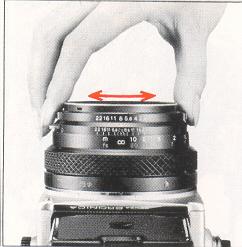 |
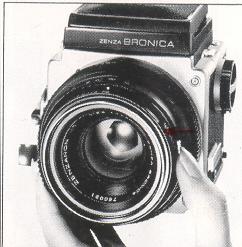 |
A. The aperture ring is rotated, in either direction, to set the required f/number opposite the white index dot. The aperture ring click-stops at the numbered settings.
Intermediate settings are also possible.
* Intermediate settings cannot be used when the AE (automatic exposure) Finder is used. |
B. All Bronica interchangeable lenses for the ETR have fully automatic lens diaphragms which means that the focusing screen is always viewed at the full aperture, with the
brightest possible image. However, den pressing the depth of field preview lever will stop the lens diaphragm down to the preselected lens opening (aperture), permitting the
photographer to check the depth of field effect on the focusing screen.
* The aperture ring must not be adjusted while the
depth of field preview lever is being depressed.
10. FOCUSING ADJUSTMENTS
A. The lens is focused on the subject, by rotating the focusing ring in either direction, while checking the effect on the microprism / split-image rangefinder spot in the center of
the focusing screen (standard type).
B. The central split-image spot splits the image diagonally, with the upper and lower halves being separated diagonally when the lens is out of focus. When in focus, however,
the two halves will coincide with the diagonal displacement disappearing. The microprism ring surrounding the central spot can also be used for checking the sharpness of the
focused image, since the image will glitter when the lens is not focused.
The full-area matte surface surrounding the central focusing aids can also be used for checking image sharpness.
11. FILM ADVANCE AND SHUTTER WINDING
Rotating the film winding crank completely one time, in the forward direction, will advance the film one frame and, at the same time,
wind the shutter, with the winding action
stopping automatically. On the other hand, short, rapid strokes, up to an accumulated full rotation, will also do the job.
12. EXPOSURE COUNTER
The exposure counter shows the number of frames exposed or, in other words, is an additive type. Starting from "S", the odd numbers 1, 3, 5, etc., up to 15, are indicated in
actual numbers while the even numbers are indicated with dots, coupled with the film winding crank action.
The letter "S" and number "15" are orange-colored while the other numbers and dots are white.
13. SHUTTER RELEASE BUTTON
A. Depress the shutter release button with the ball of the finger. Use a smooth and gentle action and press all the way in. There is no need for great strength or jerky action,
which will effect the sharpness of the picture.
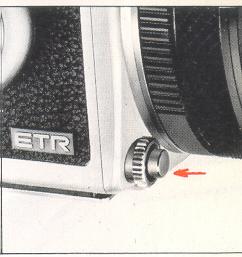 |
B. Safety Lock The shutter release button can be locked to prevent accidental operations, by simply rotating the locking ring 55° in the clockwise direction. This will place a
red dot on the side, indicating that it is locked. To release the safety lock rotate the locking ring in the counter-clockwise direction which will place the dot diagonally lower.
The shutter cannot be released, in the following cases:
1. The shutter release button is locked with the locking ring.
2. The dark slide is inserted.
3. The film winding crank has not been rotated fully. (The same is the case when the
exposure counter is still between "S" and "1".)
4. The shutter is not wound.
5. The lens is not properly attached. (The same is the case with extension tubes and bellows.)
6. The lens release button is being depressed. |
7. All available frames (15 frames on the 120 roll film and 30 frames on the 220 roll film) have been exposed.
C. If the film winding crank is rotated while the shutter release button is being depressed, the shutter will be released at the instant the winding action is completed.
D. A cable release or self-timer can be screwed into the cable release socket on the left side of the camera body.
14. DISTANCE SCALE AND DEPTH OF FIELD SCALE
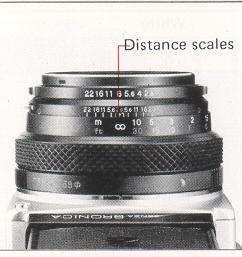 |
A. Distance scales on the Bronica lenses for the ETR can be used for setting the focus on the required distance or finding the distance actually focused. Simply rotate the
focusing ring and set the required distance opposite the green colored index, which will adjust the lens for the required distance.
|
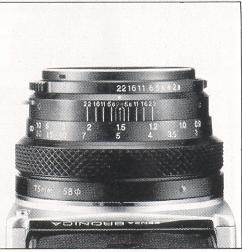 |
B. There is an apparent zone of sharpness, both in front and back of the focused subject, which is known as the depth of field. The depth of field scale shows the zone of
apparent sharpness at any lens opening or distance and can be utilized for quickly and simply ascertaining the depth of field. The depth of field scale is next to the distance
scales and is made up of identical pairs of apertures on both sides of the green
colored distance index. These identical pairs of apertures indicate the distance that will be in focus at these lens openings. For example, if the 75mm lens is focused at a distance of 1.5m, it can be seen
from the depth of field scale that the zone will extend from about 1.2 to 2.1 meters (4 ft. to 7 ft.), when a lens opening of F22 is used. |
15. INFRARED PHOTOGRAPHY
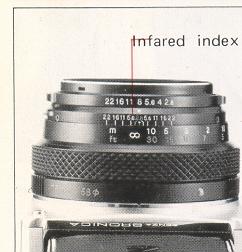 |
In infrared photography, some adjustment must be made in the focus in order to retain sharpness on the film because the invisible infrared Pays are longer in wave length than
the visible rays used for focusing. For infrared photography--
1. Use a R filter or equivalent with an infrared (black-and white) film.
2. The red-colored line, next to the green-colored distance index, is the infrared index.
3. After focusing in the normal manner, re-set the distance indicated by the green-colored distance index to the infrared index, by shifting the distance
ring. |
4. Follow instructions enclosed with the infrared film and filter and, to be on the safe side, make several bracketing shots. In general, more exposure rather than less seems to
be a safe guide.
A. The lens shutter of the Zenza Bronica ETR has a X-setting for flash synchronization, which means that electronic flash units will synchronize at all shutter speed settings,
up to the fastest 1/500 second. Thus, it is very convenient for taking shots in daylight which require flash
fill-in, too.
When using Class M and Class F flash bulbs, they will synchronize at the shutter speed settings indicated in the above table.
16. FLASH PHOTOGRAPHY
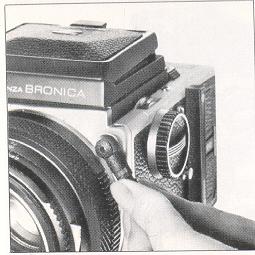 |
B. Always use flash cords with a standard PC type plug. |
17. MULTIPLE EXPOSURES
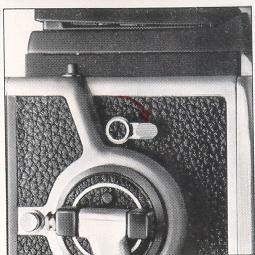 |
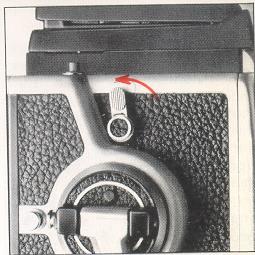 |
A. To make multiple exposures rotate the film winding crank (to advance the film and
wind the shutter) and then turn the multiple exposure lever in the clockwise or arrow-indicated direction. When set in this manner, the shutter can be released and
wound any number of times, without advancing the film. |
B. Upon taking the multiple exposed picture, be sure to return the multiple exposure lever back to its vertical position, in order to prevent inadvertent additional multiple
exposures.
18. ATTACHMENTS AND REMOVAL OF FILM BACKS
|
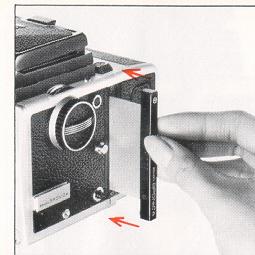
|
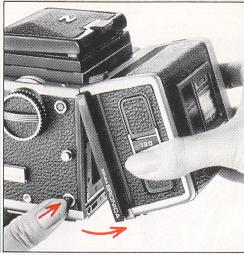
|
The camera body and film back are fully coupled at all times, upon connection. When film backs are interchanged, the shutter cannot be released if the shutter is not
wound
or the film is not advanced or both.
Upon changing the film back, therefore, always turn the film winding crank completely one time. If the shutter is not
wound or the film is not advanced, the incomplete actions
will take place when the film winding crank is rotated.
A. To remove the film back from the camera body, insert the dark slide into the dark slide slit, as illustrated, with the (3 mark on the dark slide at the top end. Push it all the way
in.
B. Depress the film back release button and the lower end of the film back can be removed, as illustrated. Simply shift the film back up slightly and pull it away.
* The dark slide can be withdrawn, even while the film back is detached from the camera body and, therefore, extra care is required, in this respect.
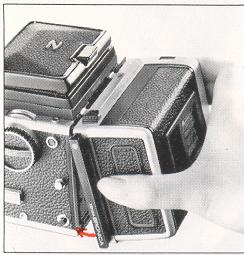 |
C. To attach the film back to the camera body, simply insert the latches at the upper end of the film back into the attachment openings at the upper end of the camera body.
Then, press the lower end of the film back against the body until it locks securely.
* The dark slide must be withdrawn from its slit, upon attachment of the film back to the body, as otherwise the shutter cannot be released. Furthermore, there is danger of the
film back accidentally becoming detached from the body, should the dark slide be left in its slit while the camera is being carried. Therefore, make it a rule to withdraw the dark
slide promptly upon attaching the film back to the body. |
19. INTERCHANGING FINDERS AND MAGNIFIERS
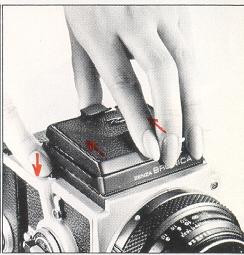 |
A. The waist-lever finder can be exchanged with
other optional finders, to match shooting operations to photographic
conditions. To detach the finder, simply depress the finder release
button, while, at the same time, sliding the finder backwards where it can
be detached. |
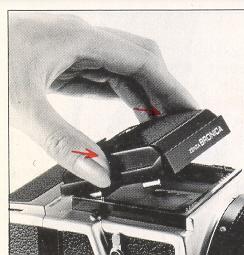 |
B. To attach the finder on the body, first, simply place protrusions on the bottom of the finder into corresponding openings in the finder frame and, then, slide the finder forward
where it will lock. |
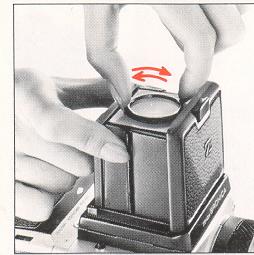 |
C. The standard magnifier supplied with the waist-level finder has a power of--1.50 diopters, which can be exchanged for others with Powers of +1.50, +0.50, --0.50, -2.50, -
3.50 and --4.50 diopters. These optional accessories should be purchased to suit the user's eyesight, if necessary.
Simply rotate the magnifier frame in the counter-clockwise direction to unscrew.
Attach in the reverse manner.
20. INTERCHANGING FOCUSING SCREENS
A. The focusing screen can be exchanged, depending on the type of photographic work being undertaken.
First, remove the finder attached to the camera body. Then, move the screen removal lever in the arrow-indicated direction, as illustrated. Finally, lift it up by the lever.
B. To install the focusing screen, insert the protrusions at the forward end of the focusing screen frame into corresponding openings in the focusing screen frame of the body.
Then, drop the rear end of focusing screen and slide the screen removal lever to the right.
C. The standard focusing screen has a split-image rangefinder spot, with the split oriented at 45° diagonal, which is surrounded by a microprism ring and, finally, a full-area
matte screen plus fresnel lens.
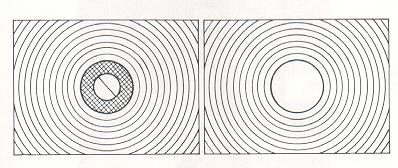
A focusing screen with matte center plus full-area fresnel lens outside the center spot is also available.
21. FILM TYPE INDICATOR FRAME
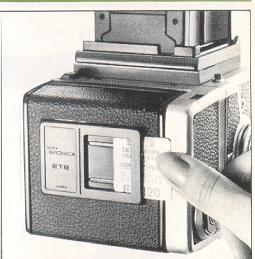 |
Upon loading the film, tear off the end flap from the empty film package and insert it in the film type
indicator frame. This will help you keep track of the film loaded in the film
back and should prove useful when two or more film backs are used, with different types of films. |
22. ATTACHING AND REMOVING THE NECK STRAP
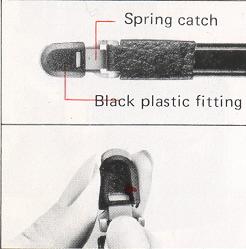 |
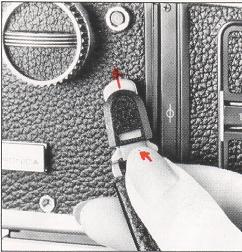 |
A. Attaching the Strap
As illustrated, press the spring catch and, at the same time, move the black plastic fitting back towards the neck strap, which will expose an opening on the opposite side.
Place the opening over the neck strap stud on the camera body and then pull strongly- on the strap, which will lock the fitting to the stud.
|
B. Detaching the Strap
Hold the neck strap, as illustrated, and depress the spring catch while, at the same time pushing the metal fitting forward, as far as it will go. Then, lift the fitting up from the
stud.
 |
C. The shoulder pad is supplied separately from the neck strap and should be used in the following manner. First, adjust the neck strap to a suitable length and then fix the
shoulder pad on the inside of the neck strap, at the point where it will rub against the shoulder.
|
23. FACTS ABOUT THE BATTERY
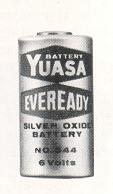
6-volt silver oxide |
The battery supplies power for the various electronic control mechanisms incorporated in the Zenza Bronica ETR. When used incorrectly, there is a possibility of the wrong
exposure being set to the camera and/or the camera not operating.
Be sure to use and store the battery correctly for obtaining optimum performance from it at all times.
* Don't leave the battery in the battery chamber for a long time, without using it, as this could lead to leakage problems and result in poor contact. Battery with leakage or
corrosion should be discarded immediately and the battery chamber should be cleaned out thoroughly, especially the contact terminals, before inserting a new battery. * Take
the battery out of the battery chamber if the camera is to be stored away or if there are no plans to take pictures in the near future. |
* Clean the contacts of the battery chamber and the battery with a soft cloth, before inserting a new battery. Don't use sandpaper or emery cloth. * Cold Weather Resistance
Although the silver oxide battery used in the Zenza Bronica ETR has a very good cold weather temperature characteristic, there is still a tendency for performance to drop
when the temperature falls below 0°C (or 32°F). Therefore, for outdoor photography in freezing weather, make it a rule to use a new battery and/or keep replacement batteries on hand. Furthermore, keep the
battery or batteries (as well as the camera) under cover, next to the body, and load the battery just before beginning the
session.
24. POINTERS ON SHOOTING WITH THE ZENZA BRONICA ETR
You will be able to use the Zenza Bronica ETR to your entire satisfaction and, thus, get better results from it, if you will take the trouble to thoroughly familiarize yourself with
the operations of the camera and fully understand the extent of its superior specifications.
* Make full use of the interchangeable film back feature.
(1)Color and back-and-white shots can be taken alternately, as required, or daylight type color film and tungsten type color film can be used interchangeably.
(2) Shooting can go on continuously, with practically no interruption if sufficient preloaded spate film backs are always available.
(3) You don't have to waste unsuitable film left over from a previous session. Simply load up a new film back, with the required film, and go out shooting.
(4) A single ETR can be used by many persons in the same studio or at home, by simply having additional film backs on hand.
* The shutter cannot be wound when film is not loaded in the film back. The use of the multiple exposure lever will, however, permit you to
wind the shutter, in such instances.
This feature is, of course, very convenient for familiarizing yourself with the camera and for testing the shutter in flash photography. (See "17. Multiple Exposures".)
*Battery power is not consumed when time exposures are made or when the ETR is used with the mechanically controlled 1/500 sec. setting.
* The voltage will drop when the camera is used for long shooting sessions in freezing weather. Insert a new battery or keep a spare on hand, for such occasions.
Furthermore, keep such batteries in an inside pocket.
* The focusing screen is detachable, for exchanging with other types. Do not place trimming masks or tapes on the bottom surface of the screen, as this will lead to inaccurate
focusing.
* See that the left hand does not touch the back cover released button, during photographic sessions, as the back cover may accidentally open and ruin the film.
* Restrict cleaning of the reflex mirror to lightly blowing or brushing away the dust and/or dirt with a blower brush or a soft camel hair brush. Don't touch the mirror surface with
your fingers or cloth.
* Clean the plastic focusing screen in the same manner, as above. Don't touch the surface as you may leave fingerprints.
* Protect your camera from sudden temperature changes, as drastic changes can result in moisture condensation, frost, etc. inside the camera which could lead to rusting of
metallic parts and eventual troubles.
* Protect your camera from impact and vibrations, as it is a precision optical instrument.
* Always protect the lens with its cover, when carrying the camera.
*When used outdoors in conditions of extreme moisture (fogs etc.,) or at the seashore, clean the camera and lens very carefully after the shooting session.
* Should the exterior of the camera be effected by salty air wipe it off carefully with a damp cloth, using fresh water. Then wipe it dry with a soft, dry cloth and, if necessary,
send it to an authorized repair station for a quick inspection.
* If the camera is not being used for a long period, store it in a cool, dry and well-ventilated (but not windy) place.
* Wrap everything individually in dry and soft lint-free cotton cloth and store in tin-lined containers, which can be closed tightly, together with plenty of
desiccant, such as silica
gel. Don't use any other kind of chemical.
* When using a tripod screw which is longer than standard, do not thread too strongly or you may cause damage to the camera body.
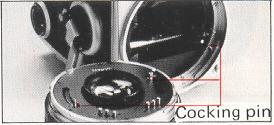 |
* The lens cannot be attached or removed unless both camera body and lens are in the "wound" condition. When the shutter is charged or
wound,
both winding pins of lens and body are set to the green colored dot. When the
winding pins are not at the position of the green dot, the winding pin of the lens can be set to the
position by simply moving it with the finger. The winding pin of the body mount
can be set to the required position by simply revolving the film winding crank. |
* Don't throw the battery into a fire, or hit it strongly, as there is danger of explosion and, consequent, damage.
*Shooting with the AE (Automatic Exposure) Finder
When a film back with a different film speed (ASA number) is attached to the camera body, readjust the film speed dial of the AE Finder for the new film speed.
25. ACCESSORIES FOR INCREASING THE VERSATILITY OF
THE ETR
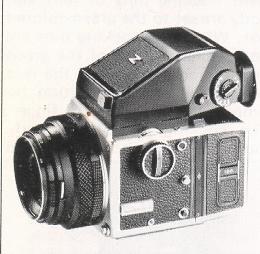 |
* Through-the-lens automatic exposure operations, of the aperture-preferred type, are possible, when the exclusive AE Finder is attached to the Zenza Bronica ETR.
Exposures are automatically controlled, upon focusing the subject, with brilliantly distinct images captured on the film. |
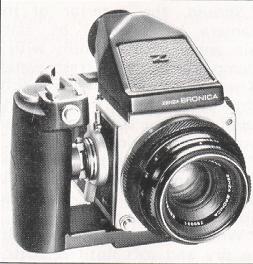 |
* Attaching the exclusive Speed Grip to the ETR converts the camera for fast operations similar to a 35mm SLR, in both horizontal and vertical formats with film advanced and
shutter wound with speed-lever action and shutter button automatically connected.
The built-in hot shoe also permits use of a cordless electronic flash unit.
|
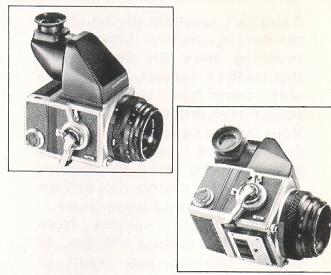 |
* The Rotary Viewfinder on the ETR makes reflex view-focusing very easy, as the eyepiece end can be rotated 90° in two directions for use in both horizontal and vertical
formats. Camera operations are greatly speeded up because a bright erect image, moving in the same direction as the lens, is observed for composing and focusing. |
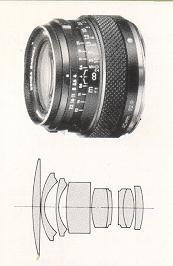 |
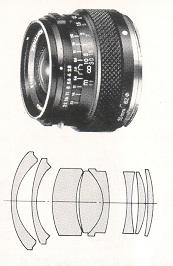 |
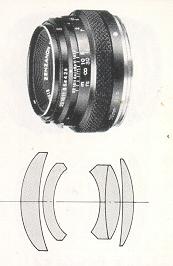 |
Zenzanon E 40mm F4
Lens construction: 9 elements 7 groups Angle of view: 82°30'
F/numbers: 4 to 22
Diaphragm: Fully automatic
Minimum focus: 40cm (1.3 ft.)
Electronic leaf shutter: Seiko #O
Shutter speeds: 8 sec. to 1/500 sec. plus T (time exposure)
Filter size: 62mm screw-in type
Length: 62mm
Weight: 478 grams (1.04 lbs.)
Equivalent 35mm focal length: 25mm |
Zenzanon E 50mm F2.8
Lens construction: 8 elements 7 groups Angle of view: 70°
F/numbers: 2.8 to 22
Diaphragm: Fully automatic
Minimum focus: 50cm (1.6 ft.)
Electronic leaf shutter: Seiko #0
Shutter speeds: 8 sec. to 1/500 sec. plus T (time exposure
Filter size: 62mm screw-in type.
Length: 62.5mm
Weight: 464grams(1.01 lbs.)
Equivalent 35mm focal length: 30mm |
Zenzanon E 75mm F2.8
Lens construction: 5 elements 4 groups Angle of view: 50°
F/numbers: 2.8 to 22
Diaphragm: Fully automatic
Minimum focus: 60cm (2 ft.)
Electronic leaf shutter: Seiko #O
Shutter speeds: 8 sec. to 1/500 sec. plus T (time exposure)
Filter size: 58mm screw-in type
Length: 54.3mm
Weight: 417 grams (1.2 lbs.)
Equivalent 35mm focal length: 46mm
|
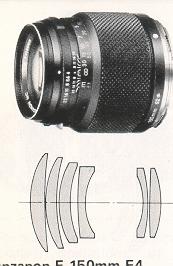 |
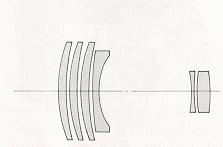 |
Zenzanon E 150mm F4 Lens construction: 6 elements 6 groups
Angle of view: 26°30'
F/numbers: 4 to 22
Diaphragm: Fully automatic
Minimum focus: 1.5m (4.9 ft.)
Electronic leaf shutter: Seiko #o
Shutter speeds: 8 sec. to 1/500 sec. plus T (time exposure) Filter size: 62mm screw-in type
Length: 86mm
Weight: 605 grams (1.3 lbs.)
Equivalent 35mm focal length: 90mm |
Zenzanon E 250mm F5.6
Lens construction: 6 elements 6 groups
Angle of view: 16°
F/numbers: 5.6 to 22
Diaphragm: Fully automatic
Minimum focus: 3.5m (11.5 ft.)
Electronic leaf shutter: Seiko #o
Shutter speeds: 8 sec. to 1/500 see plus T (time exposure) Filter size: 62mm screw-in type
Length: 148mm
Weight: grams
Equivalent
35mm focal length: 150mm |
DEPTH OF FIELD TABLES
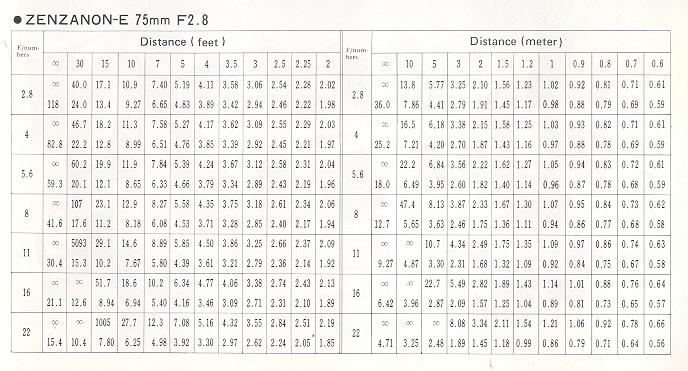
ACCESSORIES FORTHE ZENZA BRONICA ETR
